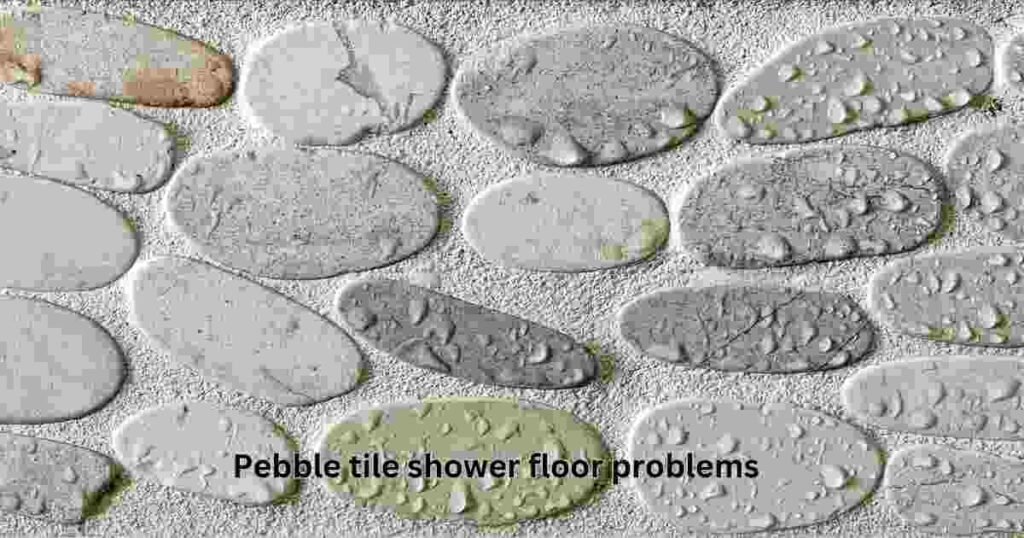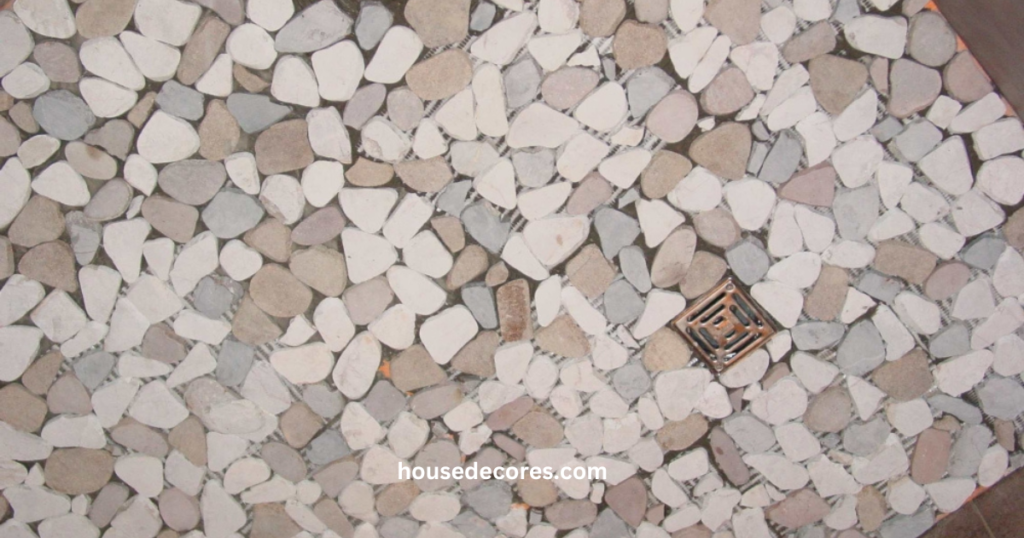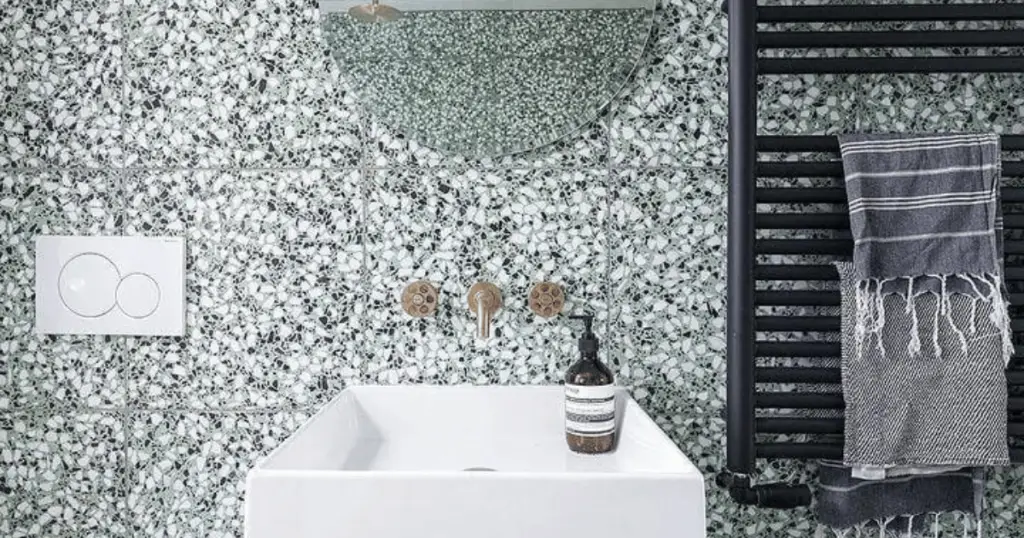- Introduction:
- Problems:
- Water pooling on the pebble shower floor
- Is pebble tile good for the shower floor?
- The pebble shower floor turned white
- Our recommendations:
- Pebble tile shower floor problems pictures
- How to repair it?
- Grout for pebble shower floor
- Does pebble tile hurt your feet?
- How to clean?
- Pros and cons
- Can you regrout pebble shower floor?
- Conclusion:
Introduction:
A pebble tile shower is a type of shower that uses small, smooth stones called pebbles to cover the floor and the walls. These pebbles are usually made from natural materials. They’re arranged tightly together, creating a textured surface that’s pleasant to walk on and adds a natural look to the shower. The stones are often set into a mesh backing for easy installation, and they come in various colors and shapes to suit different preferences and styles. Overall, a pebble tile shower brings a touch of nature into the bathroom, providing a unique and visually appealing design element.
Problems:
- It is uncomfortable to walk on a pebble tile shower without shoes.
- Dirt and grime get trapped between the pebbles which makes it challenging to clean thoroughly.
- The small gaps between the pebbles collect water, creating a slippery surface that increases the risk of falls.
- Grout lines between the pebbles deteriorate over time, leading to water penetration and potential mold growth.
- Regular maintenance is required to keep the pebble tile shower floor in good condition, including sealing and cleaning the grout lines.
- Pebble tile shower floor is more expensive because its cost varies from $5.55/sq. ft. $9.29/sq. ft.
Water pooling on the pebble shower floor
Water pooling on a pebble shower floor poses safety risks and affects the aesthetic appeal. Proper installation with a sloped floor towards the drain is crucial, ensuring efficient water drainage. Regular inspection and cleaning of drainage channels prevent blockages. Using a quality shower mat and employing a post-shower routine with a squeegee minimizes water pooling, enhancing safety and the longevity of the pebble floor.
Is pebble tile good for the shower floor?
Yes, pebble tiles, such as the high-quality Vim Shower Pan, are good because made from natural stones, bringing a unique, earthy look to the bathroom and invoking a spa. The irregular shapes and textures of the pebbles offer a slip-resistant surface, enhancing safety in wet conditions. Optimal drainage is facilitated by the spaces between the pebbles, preventing water pooling and promoting efficient water flow toward the drain. However, the success of a pebble tile shower floor largely depends on the quality of materials and the precision of installation. Investing in high-grade, durable pebble tiles and employing professional installers ensure longevity and minimize potential issues.
The pebble shower floor turned white
The issue of a pebble shower floor turning white is attributed to various factors, necessitating a closer inspection for an effective resolution. One common culprit is the accumulation of mineral deposits or soap scum on the pebble tiles, leading to a cloudy or white appearance. Regular cleaning with a mild, non-acidic cleaner is crucial to eliminate these deposits and restore the natural beauty of the stones.
In some cases, the white appearance could be a result of efflorescence, a natural process where salts migrate to the surface of the stones. A thorough cleaning with a specialized efflorescence cleaner is recommended to address this. Identifying the root cause of discoloration is crucial for an effective solution, maintaining the visual appeal of your pebble shower floor and preventing unsightly white spots.
Our recommendations:
Pebble tile shower floor problems pictures


How to repair it?
There are following these steps to troubleshoot and fix common problems:
- Begin by carefully examining the entire shower floor. Identify areas with water pooling, and grout cracks.
- Use a mild, non-acidic cleaner to remove any soap scum deposits. We clean between the pebbles and along the grout lines.
- Apply a high-quality grout sealer to protect the grout from moisture and prevent future cracking. This step enhances the longevity and durability of the pebble shower floor.
- If you spot any grout cracks, carefully remove the damaged grout using a grout saw. Mix a small batch of grout according to the manufacturer’s instructions and fill in the gaps. Wipe away excess grout before it dries.
- Ensure the shower floor has a proper slope towards the drain. If water pooling persists, consult a professional to assess and adjust the floor’s slope for optimal drainage.
- Develop a routine for post-shower maintenance. A squeegee removes excess water, preventing water accumulation and potential damage.
Grout for pebble shower floor
Grout for a pebble shower floor is a special material used to fill in the gaps between the pebbles, creating a smooth, even surface. It is the glue that holds everything together. Without grout, the pebbles would be loose and unstable, making the floor uncomfortable and prone to water leakage. Grout comes in different colors to match the pebbles or complement the overall design of the shower. It’s important to choose the right type of grout that is waterproof and resistant to mold and mildew, ensuring the longevity and cleanliness of the shower floor.

Does pebble tile hurt your feet?
Pebble tile hurt sometimes feet. The little stones on the tile feel uncomfortable, especially when you walk on them barefoot. It is not a big problem if you just step on them quickly, but if you walk on them for a while, it could start to bother you. It is also depends on your sensitivity and how much time you spend on the pebble tile.
How to clean?
- Vacuum the pebble tile shower floor to remove loose dirt and debris.
- Combine warm water with a pH-neutral cleaner in a bucket.
- Dip a soft-bristled brush into the cleaning solution and gently scrub the pebble tiles, focusing on stains.
- Thoroughly rinse the floor with clean water to remove any soap residue.
- For stubborn stains, use a mixture of water and a specialized stone cleaner.
- Dry the floor with a clean towel and allow it to air dry completely.

Pros and cons
| Pros | Cons |
|---|---|
| Pebble shower floors have a natural peaceful riverbed, making our bathroom look and feel better. | Dirt and soap scum stick more on bumpy surfaces than flat ones, making it harder to keep clean. |
| Without good airflow and care, water gets trapped between the pebbles, making it easy for mold and mildew to grow. | Without good airflow and upkeep, water gets trapped under the pebbles in the shower, leading to mold. If not dealt with promptly, this makes the shower unhealthy and dirty. |
| A pebble shower floor’s bumpy surface gives you more grip and helps prevent slipping, which is great for safety, especially in wet conditions, making our bathroom safer. | Uneven pebble shower floors might feel uncomfortable to stand on for some people, especially those with sensitive feet, making showering less comfortable for them. |
| Gaps between the stones in the shower floor help water drain away quickly. This stops water from sitting and causing mold, keeping the shower clean and dry. | Walking on a bumpy surface might feel uncomfortable, especially if we have sensitive feet. This could make showering less comfortable for some people. |
| Standing on an uneven surface for a long time might feel uncomfortable for some people. This is especially true if you have sensitive feet. | Putting in a pebble shower floor is harder and takes more work than installing regular tiled flooring. |
Can you regrout pebble shower floor?
The answer is yes, by doing these steps you can regrout the pebble shower floor:
Make the pebble floor clean and free of any debris, soap scum. Use a sponge along with a mild cleaner to scrub the surface thoroughly. Rinse off the cleaner with water and let the surface dry completely. Any moisture left on the surface could affect the grout’s ability to adhere properly.
And then select the correct type of grout because it is crucial for a successful regrouting job. For a shower floor, it’s best to use a grout specifically designed for wet areas, such as epoxy grout.
Protect surrounding surfaces from accidental spills. Masking for tape to cover edges and fixtures near the pebble floor. Additionally, inspect the pebble floor for any loose.
Follow the manufacturer’s instructions to mix the grout properly. Typically, this involves combining the grout powder with water in a clean container until you achieve a smooth, lump-free consistency. Use a stirring stick or a grout mixer attachment for a drill to ensure thorough mixing. A
Once the grout is mixed to the correct consistency, use a grout float to apply it to the pebble floor. Hold the float at a 45-degree angle and spread the grout evenly, working it into the gaps between the pebbles.
After allowing the grout to be set for a few minutes, use a damp sponge to remove excess grout from the surface of the pebbles. Rinse the sponge frequently in clean water to prevent smearing grout over the surface.
Once the grout has fully cured according to the manufacturer’s recommendations, typically 24 to 72 hours, use a towel to polish the surface of the pebbles and remove any remaining haze or residue left behind by the grout.
Conclusion:
Pebble tile shower floor problems become evident and a proactive and thoughtful approach is essential for maintaining the beauty and functionality of this unique bathroom feature. By adhering to meticulous installation practices, choosing quality materials, and implementing routine maintenance, homeowners can mitigate common issues such as water pooling, grout cracks, and discoloration. The careful selection of appropriate grout, regular cleaning, and prompt repairs contribute to the long-term durability of the pebble shower floor. Ultimately, with attention to detail and a commitment to these preventive measures, your bathroom can showcase a stunning and enduring pebble tile shower floor, providing aesthetic appeal and a comfortable, relaxing space for years to come.


